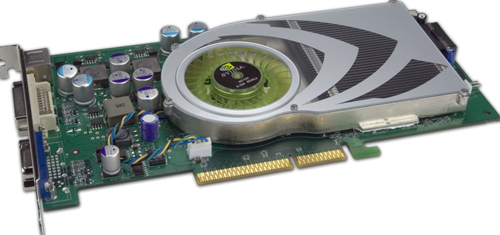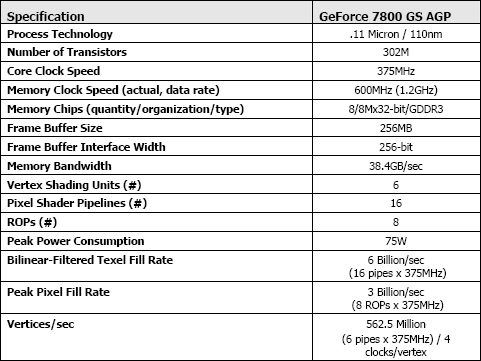The Card and The Test
As mentioned, we currently have both a 7800 GS from EVGA and the 7800 GS OC from BFG. Neither of these cards run at the default 375/1.2 clock speeds set forth by NVIDIA. For the purposes of these tests, we underclocked a card to the minimum speed that NVIDIA is endorsing. With the high clock speeds that we see from BFG and EVGA, we'd be willing to bet that even 7800 GS parts that don't come factory overclocked would have some head room. The EVGA card is clocked at core/mem clocks of 460/1.35, while the BFG part runs at 400/1.25. It is interesting to note that the BFG part makes a bigger deal out of being overclocked on the box than the EVGA card, but either way, the 7800 GS is no slouch.
Gigabyte K8U-939 ULi based motherboard
AMD Athlon 64 FX-57
2x 1GB OCZ PC4000 RAM @ 200MHz 2:3:3:8
160GB Seagate 7200.7 HD
OCZ 600W PowerStream PSU
For reference, we have included the 7800 GTX 512 and the X1900 XTX. This gives us a clear look at the highest end ATI and NVIDIA hardware available for both the AGP and PCIe platforms. The 7800 GT is also included in order to show us the performance of the next fastest NVIDIA part out there.
Here's a breakdown of the 7800 GS specifications as outlined by NVIDIA.
As mentioned, we currently have both a 7800 GS from EVGA and the 7800 GS OC from BFG. Neither of these cards run at the default 375/1.2 clock speeds set forth by NVIDIA. For the purposes of these tests, we underclocked a card to the minimum speed that NVIDIA is endorsing. With the high clock speeds that we see from BFG and EVGA, we'd be willing to bet that even 7800 GS parts that don't come factory overclocked would have some head room. The EVGA card is clocked at core/mem clocks of 460/1.35, while the BFG part runs at 400/1.25. It is interesting to note that the BFG part makes a bigger deal out of being overclocked on the box than the EVGA card, but either way, the 7800 GS is no slouch.


Gigabyte K8U-939 ULi based motherboard
AMD Athlon 64 FX-57
2x 1GB OCZ PC4000 RAM @ 200MHz 2:3:3:8
160GB Seagate 7200.7 HD
OCZ 600W PowerStream PSU
For reference, we have included the 7800 GTX 512 and the X1900 XTX. This gives us a clear look at the highest end ATI and NVIDIA hardware available for both the AGP and PCIe platforms. The 7800 GT is also included in order to show us the performance of the next fastest NVIDIA part out there.
Here's a breakdown of the 7800 GS specifications as outlined by NVIDIA.











93 Comments
View All Comments
APKasten - Thursday, February 2, 2006 - link
No. It could be considered a contradictory statement. An oxymoron is a phrase, not a sentence. ;)But I still disagree with you. Since AGP is still a viable platform for playing current games. In fact, the 7800 GS keeps AGP systems relevant, because it puts an AGP card on the market that utilizes the most advanced kinds of mainstream video technology.
Alphafox78 - Thursday, February 2, 2006 - link
dittoJWalk - Thursday, February 2, 2006 - link
I would be interested in seeing the scores from the eVGA version of this card. It has significantly higher clock speeds. I would expect that it gives quite a bit better scores. As it stands now though, if I were looking for an AGP card, I would look toward the X850 XT. The non-PE version can be found for $250 or less. The stock-clocked 7800 GS is a nice card, but not a very good deal at $300 or more.So, to conclude, looking forward to some numbers from the over-clocked eVGA 7800 GS. :-)
neogodless - Thursday, February 2, 2006 - link
Unfortunately, comparing this card only to cards that are PCI Express only or you won't be upgrading from (like the X850XT PE) is kind of pointless...I say this because I think the question worth asking is "Is this card a viable upgrade for AGP users", so you would want to compare it to cards like the 6800GT, 6800, 6600GT, and perhaps those Radeon counterparts. Then, having the X850 line in there for comparison would give you a good idea as to which you'd want to upgrade to.
Alphafox78 - Thursday, February 2, 2006 - link
I second this, why not put in a 6800GT or Ultra? if you have a 6800 card it would be nice to know if this card is faster. I stopped reading after I found out there were no cards I found usefull to compare it against..OvErHeAtInG - Thursday, February 2, 2006 - link
Also, both the X850 XT and X800 XT were available in AGP. I think the poster was looking for a way to get SM3.0 by swapping out his X850 XT AGP ?DerekWilson - Thursday, February 2, 2006 - link
The PCIe numbers are useful to AGP users in that it shows where the cutoff between the highest possible AGP performance is and the next step up in performance possible on a PCIe platform.That being said, we are planning on looking at the AGP version of the X1600 as compared to the AGP 6800 GS, so we will certainly revisit this issue.
Thanks,
Derek Wilson
fishbits - Thursday, February 2, 2006 - link
Huh? If you're using AGP and looking to upgrade the video card, what does it matter what the PCIe cards are scoring? If you'd decided to go PCIe, pretty much any of the cards out would be better in one way or another. Maybe just throw in one 7800 GT or such for that comparison. What's "useful" to someone looking to uprade an AGP card is how it will perform compared to what he has, a 6600GT, 6800GT, 6800GS (AGP version), a 97-9800 and a few of the XXX800XLXXLX X's. That's what they need to be able to see if the card's worth it, or maybe it is time for them to switch to PCIe. Speaking of which:AT's been on this jag for a while now. It was just 18 months ago you were recommending an AGP board as your "Editors Choice" to readers. While some upgrade more frequently, I don't see the guy who buys a top-of-the-line mobo and expects to get two years out of it as in the same category as the guy trying to nurse his Sempron system along. Oh well, at least it's better than when PCIe was available for less than a year and offering zero performance benefits compared to AGP, yet AT was insisting that avid gamers shouldn't expect to see any new AGP products.
/rant
GoatMonkey - Thursday, February 2, 2006 - link
You forgot a few "T"s.
hshendon - Thursday, February 2, 2006 - link
Anyone know what the numbers are for the same tests for a 6800 Ultra?I think I am happy to see that there is a 7800 part for the AGP users out there like me, but I am not sure if I should get it because I can never find comparisons to the 6800 Ultra.
I know I would get the better shader model and more pixel pipelines, but what does that really mean in a head to head comparison?